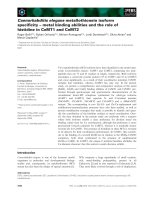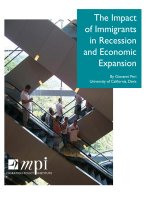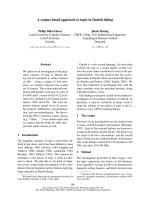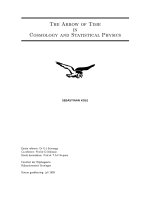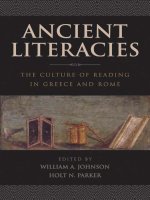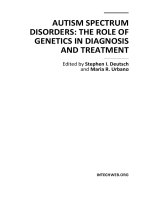The gulf of mexico oil spill a corpus based study of metaphors in british and american media discourse 3 3
Bạn đang xem bản rút gọn của tài liệu. Xem và tải ngay bản đầy đủ của tài liệu tại đây (374.09 KB, 14 trang )
119
It is vital to note that this diagrammatic classification is ultimately a
mental model or an “abstract inference from linguistic evidence” (Charteris-
Black, 2004, p.244). However, this hierarchical organisation enables us to
identify interrelationships between metaphors and assists in accounting for
coherence in the discourse under analysis. This diagrammatic representation
also enables us to see connections in an otherwise unrelated complex of
sprawling metaphors. Hence, the IICM proposes a systematic and unique
amalgamation of frameworks and methods in order to improve the inductive
and empirical aspect of the formulation of conceptual metaphors from
linguistic metaphors. The deliberate reliance on empirical suggestion by two
leading integrated concordancing software platforms coupled with the
systematic mapping from linguistic evidence to conceptual categories through
the judicious use of corpus-based dictionaries attempt to add a modicum of
empirical reliability and inductiveness in the intertwined processes of
conceptual metaphor identification, formulation and interpretation. .
3.5.4. Phase Three – Analysis and Generalisation (Critical Metaphor
Analysis)
3.5.4.1. Image schemas and entailments
Lakoff & Johnson (1980) define ontological metaphors as metaphors
that transpose abstract concepts, events and ideas onto physical entities or
substances. These metaphors serve a heuristic function in developing our
understanding about complex interrelationships between language, thought
120
and social context. Chilton (1996) has also identified four specific image
schemas that have been predominantly used in the discourse of media and
politics. These include the CONTAINER schema (in reference to defending and
shielding from negative external forces), the PATH/JOURNEY schema (in
reference to the concept of a mission and its accompanying obstacles), the
FORCE schema (which encompasses notions of offence and defence) as well as
the LINK schema (with direct references to relationships between state
entities). Inherent within these four image schemas is the idea of
metaphorical entailment where the characteristics and motivations of the
source domain are transposed onto the more abstract target domain (Chilton,
1996, p.56). This notion of entailment will be taken in tandem with the socio-
cultural contexts to form the basis for the analysis and evaluation of the
associated British and American metaphors in this thesis.
3.5.4.2. A holistic diagrammatic depiction: The interaction of metaphor
categories for ‘Substances and materials: Liquid (NYT_1_‘OIL’) –
Table 3.4 & Fig. 3.16
This adaptation of Grady, Taub & Morgan’s diagrammatic
representations potentially accounts for the phenomenon of metaphor cross-
classification and showcases the interaction between the various metaphor
categories. The four categories of metaphor are Structural Metaphors,
Ontological Metaphors, Orientational/Spatial Metaphors and Image/Analogy-
based Metaphors (See Section 3.3.4). The overall distribution of the metaphor
categories and the associated metaphors are captured in Table 3.4.
121
Table 3.4.
Metaphor and Token Distribution in NYT for the node word – ‘Oil’
Conceptual Key
(Scenario)
Metaphor
Total
(Types)
Total
(Tokens)
THE OIL IS A THREAT
(DANGER)
*Structural/Ontological
(Personification) /Analogy
35 instances
THE OIL IS AN ESCAPING ANIMAL
*Personification
THE OIL IS A THREAT TO BE CURTAILED
(FIRE/SICKNESS)
*Analogy
THE OIL IS A THREAT TO BE OVERCOME
(DANGER)
*Analogy
THE OIL IS A POWERFUL FORCE (ADVERSARY)
*Personification
THE OIL IS THE ENEMY
*Personification
CLEANING THE OIL SPILL IS A WAR
*Structural Metaphor
THE OIL SPILL IS A WARNING FROM HELL
*Analogy
7
35
THE OIL IS A SICKNESS
(HEALTH AND DISEASE)
*Structural/ Analogy
9 instances
THE OIL SPILL IS A CONTAGIOUS DISEASE
*Analogy
THE ENVIRONMENT IS A BODY
*Analogy
THE OIL WELL IS A BODY PART (ARTERY)
*Analogy
THE OIL IS A THREAT (DISEASE/POISON)
*Analogy
4
9
THE OIL IS A LIVING
ENTITY
* Ontological (Personification)
19 instances
THE OIL IS AN ESCAPING ENTITY
*Personification
THE OIL IS A POWERFUL ENTITY TO BE
SUBDUED
*Personification
2
19
THE OIL WELL IS A LIVING
ENTITY
(PERSONIFICATION:
HEALTH AND DISEASE)
*Ontological (Personification)
/Analogy
15 instances
THE OIL WELL IS A BLEEDING PERSON
*Personification
THE OIL WELL IS A BODY PART
(RUPTURED ARTERY)
*Analogy
THE OIL WELL IS A PATIENT
*Personification
THE OIL WELL IS A HANDICAPPED PERSON
(CRIPPLED PERSON)
*Personification
THE OIL WELL IS A SPEWING PATIENT
*Personification
5
15
THE ENVIRONMENT IS A
LIVING ENTITY
(PERSONIFICATION:
HEALTH AND DISEASE)
*Analogicall Metaphor
5 instances
THE OIL IS POISON
*Analogy
THE OIL IS A SICKNESS
*Analogy
2
5
122
THE PLAN IS A LIVING
ENTITY (BODY POLITIC)
*Ontological (Personification)
/Analogy
2 instances
THE PLAN IS A LIVING ENTITY (BODY POLITIC)
*Ontological Metaphor/Analogy
1
2
BP IS A PERSON
(PERSONIFICATION:
CRIME/ INCOMPETENCE)
*Ontological (Personification)
31 instances
BP IS AN UNREPENTANT PERSON
*Personification
BP IS A CRIMINAL (LIAR)
*Personification
BP IS AN INCOMPETENT PERSON (FAILURE)
*Personification
BP IS AN UNTRUSTWORTHY PERSON
*Personification
THE OIL WELL IS AN UNCONTROLLABLE
ENTITY
**Personification
5
18
THE MMS IS A PERSON
(PERSONIFICATION:
INCOMPETENCE)
*Ontological (Personification)
1 instance
THE MMS IS AN INCOMPETENT LAW
ENFORCER
*Personification
1
1
Orientational/Spatial Metaphors
CAPPING THE SPILL IS A
JOURNEY (PATH-
MOVEMENT)
* Structural/ Spatial/
Orientational Metaphor
5 instances
GOOD IS FORWARD
*Spatial/Orientational Metaphor
1
5
BAD IS BIG
(SCALE)
*Orientational Metaphor
17 instances
BAD IS BIG
*Orientational Metaphor
1
17
Grand Total
29
127
Table 3.4 provides an empirical overview of the metaphorical
categories and their overall distribution for the node word ‘oil’. It is clear that
the Conceptual Keys - often represented by Structural Metaphors
(encapsulated by the scenarios of DANGER and HEALTH AND DISEASE) and
Ontological Metaphors (mainly personified by the scenarios of CRIME and
INCOMPETENCE) - provide the reader with heuristic scaffolding required to
grasp the potentially abstract concepts involved in the entire disaster.
Ontological Metaphors and Analogy-based Metaphors form the majority of
the pre-identified metaphor categories. Ontological Metaphors comprise 16
out of a possible 29 metaphor types whilst Analogy-based Metaphors take up
123
10 out of 29 metaphor types. Orientational/Spatial Metaphors take up 2 of
the remaining tokens. In terms of raw frequency counts embodied by the
number of tokens, it is interesting to note that the predominant scenarios tend
to be those of DANGER (35 out of 127 tokens), CRIME (29 out of 127) and
HEALTH & SICKNESS (18 out of 127) respectively. A deeper analysis of this
preliminary statistic seems to imply that the overarching categorisation of the
oil as a THREAT (WAR/ HEALTH & SICKNESS) intertwines largely with the
PERSONIFICATION of the various entities in the discourse e.g. BP, the oil, the
oil well, the environment and the US Government. This seems to imply that
the overriding theme inherent in the discourse is a narrative of conflict
between various entities.
Figure 3.16 is an ambitious attempt to demonstrate how the complete
range of Structural Metaphors and Ontological Metaphors relate to the
Orientational/Spatial and Analogy-based metaphors in one coherent
complex. The Conceptual Key category divides the overarching source
domain of the oil as a THREAT systematically and coherently into the WAR,
CRIME and the HEALTH & DISEASE subsets. This can be seen in the way the
WAR and CRIME scenarios overlap with the JOURNEY scenario of capping the
oil spill. This is captured by the powerful experiential concept of the oil being
seen as a “POWERFUL ADVERSARY” or “THREAT TO BE CURTAILED
(FIRE/SICKNESS)” as well as the way measures are being “pursued” in order to
overcome “setbacks” and “obstacles” (Orientational/Spatial Metaphors). As
JOURNEY metaphors highlight the idea of progress and a single-minded sense
of purpose, it is often utilised by politicians who have to be concerned with
“goal oriented social activities” for positive self-depiction (Charteris-Black,
124
2004, p.74). Thus, the concept of PROGRESS in this preliminary examination of
the NYT corpus is embodied by the concept of “moving ahead” in the right
direction. Furthermore, the Ontological Metaphors personifying the agencies
and government organisations involved serve to give a complete
characterisation of the perceptions endorsed by the NYT editorial team. The
portrayal of BP as a CRIMINAL and as an INCOMPETENT or UNTRUSTWORTHY
person, the highlighting of the role of the government as an INCOMPETENT
LAW ENFORCER as well as the portrayal of the environment as a LIVING
ORGANISM “poisoned” and afflicted by the “plague” of oil, gives an insight
into the roles and agencies of the relevant parties. These ontological metaphors
provide a heuristic function in aiding the reader to make connections and
integrate complex sequences of events. Furthermore, the conceptualisation of
the plan to cap the oil spill as a living entity with a “heart” highlights a
different aspect of the Ontological Metaphors i.e. “the heart” of the industry’s
plan, the “heart” of the response and the “heart” of the engineering problem. A
separate search for the lemma “heart” was carried out with Sketch Engine. The
word sketch and the screenshot of the relevant concordance can be seen in
Figures 3.17 and 3.18 respectively.
125
Fig. 3.17.
A word sketch of the lemma ‘Heart’ in Sketch Engine
Fig. 3.18.
A concordance of generated of the lemma ‘Heart’ in Sketch Engine (All 17 instances)
Figures 3.17 and 3.18 show how the BODY POLITIC metaphor is utilised in the
NYT corpus. It is interesting to note how the HEALTH & DISEASE domain is
intertwined seamlessly with the BODY POLITIC metaphor in Fig. 3.18 where 12
out of 17 instances of the lemma “heart” are made in reference to it. This is
clearly illustrated in the modifiers to the noun where the operation to halt the
leak is described as a “heart surgery under 5000 feet of water” and where the
126
oil industry is described as the vital “heart” of the economy that results in
“organ failure” if it stops functioning. Furthermore, the significance of the oil
spill in the Gulf is further emphasised when it is described as a near-fatal blow
to an individual i.e. as a “heart attack in New York City”. The further
conflation of the BODY POLITIC metaphor with that of a THREAT (CRIME) is
clearly illustrated when BP was accused of being a serial murderer that has
“ripped the heart out of yet another hard-working local community”. Thus, it
is vital to note that metaphor groupings such as WAR, CRIME, JOURNEY and
DISEASE influence and constrain the public’s political imagination by
imposing these relevant concepts onto social and political realities. This
underscores the importance of identifying and unravelling the relevant
conceptual metaphors from a critical perspective. This is because those in
positions of power and control are able to constrain public perceptions through
the selective use of metaphor systems in the communication of these
representations.
3.5.4.3. A holistic diagrammatic depiction: Scenario interaction for
‘Substances and materials: Liquid (NYT_1_‘OIL’) – Fig 3.16
It is well known that in media discourse, the domain of war is
employed as a metaphorical representation for all types of human struggle and
conflict. Politicians often utilise WAR metaphors in an effort to galvanise the
electorate against a common perceived threat, in the process foregrounding the
personal sacrifice that is needed in order to achieve the greater good. Hence, in
this case, BP and the oil spill are conceptualised as THREATS or as ENEMIES in
127
order to provide a common cathartic target for the masses. This is clearly
illustrated in the use of military references where there is a need to “deploy” a
new system to “contain” the threat posed by the oil and the need to “stop” and
“capture” the CRIMINAL (OIL) in order prevent further havoc from being
wreaked on the ecosystem. However, it is interesting to note that for this NYT
corpus, the scenario of WAR is mainly conflated with two accompanying
scenarios – namely the scenario of THREAT, and that of HEALTH & DISEASE.
This is clearly seen in in Fig. 3.16. A quick overview shows that the scenario
of WAR and the personification of the entities involved (e.g. BP, the oil, the
government and the environment) seem to indicate that criminal acts of
aggression have taken place amongst these parties. The CRIME scenario entails
the shrewd use of tactics as well as retaliatory responses by the US
government in order to regain a measure of justice. This is clearly seen by the
resultant depiction of BP as a CRIMINAL, AGRRESSOR and as a POWERFUL
ENTITY TO BE SUBDUED in order to be brought to justice so as to ensure the re-
attainment of social equilibrium. The conflation of the WAR and CRIME
scenarios also entails a degree of aggression by the oil industry (specifically by
BP) on the ‘ecologically fragile environment’ that has been “poisoned” by the
spilt oil. Such irresponsible acts have thus resulted in a “stricken” and
“crippled” victim who requires emergency aid in order to “stanch” the
resultant bleeding. The conflation of both the CRIME and HEALTH & DISEASE
scenarios also serve to implicate the government’s incompetence, negligence
and the inability to enact change in a severe situation. Hence, it is clear that
the WAR scenario is used to sustain cohesion virtually throughout the NYT
corpus, albeit across discrete articles and writers. A good reason in accounting
128
for such a metaphorical confluence in the depiction of a single issue can be
attributed to the shared characteristics between capping the BP oil spill and
fighting a war. The specific overlaps include the “us against them” mentality,
the need for justice to be served, the need for sacrifice by all the parties
involved in order to ensure victory and the use of resources and technology in
order to achieve the relevant definitions of success.
A closer examination of the conflation of these three scenarios
foregrounds the embodiment of the affected parties as individual persons
(victims and patients). Firstly, the WAR scenario depicts the oil as an ENEMY
and personifies it as an ENTITY ESCAPING JUSTICE or a POWERFUL
AGGRESSOR. This serves to galvanise the readers to respond as a unit to rise
up and bring BP the CRIMINAL to justice in order to provide recompense to
the victims. However, a closer reading of the expanded contexts in Texts 3.1
and 3.2 show a double-edged quality in the depiction of these metaphors.
Text 3.1
A context expansion in Sketch Engine ‘Spill’ in Word Sketch - Obj of
Text 3.2
A context expansion in Sketch Engine ‘Stop’ in Word Sketch - Obj of
The pro-government response serves to depict the Obama
Administration and the US legal machinery as competent and key functioning
129
units relentlessly fighting against the odds in the interests of its citizenry. Text
3.1 clearly depicts the Obama Administration and the government as a
competent legal prosecutor utilising a range of “aggressive” strategies to bring
BP the criminal to justice. This seems to demonstrate that the US government
is taking concrete actions to address the grievances of the electorate. However,
Text 3.2 highlights the toothlessness and ignorance of the “joint government
and industry task force” in halting the path of destruction carved out by the
unpredictable and significant threat posed by the significant amounts of oil
leaking from the oil well. Hence, the divergent political affiliations of
individual writers within the same broadsheet can be identified through a
context expansion of the selected node words. This provides the analyst with
the capacity to either analyse individual occurrences with an in-depth look at
the specific context of the node word or to take a step back and quantify the
number of concordances either chastising or commending the efforts of the
administration. Thus, this provides an empirical justification for the perceived
overarching political leanings endorsed by the broadsheets selected for
analysis. A possible area for further analysis would be to cross-reference the
collocates of the same target node word in an overtly conservative broadsheet
like the Washington Post so as to lay bare the underlying ideologies and
affiliations.
Secondly, the foregrounding of the HEALTH AND DISEASE scenario
portrays the environment as a living organism that requires constant care and
protection. HEALTH AND DISEASE metaphors are commonly used as evaluative
markers in discourse as they are universally accessible scenarios for all. The
personification of the environment as a chronic patient requiring “long-term
130
restoration” as a result of being “plagued” or “poisoned” by the oil illustrates
this metaphor of sickness. The vilification of the parties involved in this
disaster is rendered complete when the oil well is described as a “stricken”
patient or “bleeding victim” that is “spewing black poison” into the Gulf as the
result of criminal negligence by those in positions of power. The
personification of the environment and the ruptured oil well as VICTIMS/
PATIENTS provides a legitimate account of the complex of metaphors i.e. with
the scenario of the oil as a THREAT – namely under the overarching scenario of
HEALTH & DISEASE (POISON/CONTAGIOUS DISEASE). Thus, this adaptation of
Grady et al.’s (1996) concept of metaphorical compounds and primitives
serves to adequately address the issue of metaphor cross-classification. In this
case, the resultant metaphorical compound accounts for the conflation of the
WAR, CRIME and SICKNESS scenarios. The power of such a diagrammatic
organisation of the conceptual keys (scenarios)/metaphors also provides the
analyst with a birds’ eye view of the complete range of metaphors and their
inter-relationships in a large and representative stretch of discourse. The key
advantage of this diagrammatical approach lies in the way the analyst has to
take into account the holistic socio-political and cultural contexts in order to
account for the resultant metaphorical entailments. This avoids the
interpretative myopia that comes about with an overt focus on concordance
lines and the narrow expanded contexts.
3.6. Summary
This section demonstrates the potential utility of the WMatrix and
131
Sketch Engine software in the empirical and objective generation of semantic
domains as well as the empirical suggestion of the relevant lexical items for
further metaphorical analysis. This empirical objectivity is underlined by the
fact that these domains and lexical items are “suggested” for analysis by these
integrated online concordancing platforms in terms of the empirical frequency
of overuse embodied by the Log-Likelihood values. Coupled with the
procedures proposed by the IICM (to be improved with additional refinements
and subsequent iterations), a systematic analysis of the range of conceptual
metaphors and their relevant interconnections can be obtained. A deeper
analysis of the relevant contexts and ideas can be achieved through an
expansion of the surrounding contexts of the node words for an in-depth
critical analysis that takes the historical, social and contextual details into
account. Hence, by marrying qualitative analysis with quantitative salience,
we are able to analyse the subtle cross-cultural differences in a comparative
approach. This method also seeks to find the adequate balance between semi-
automatic and manual analysis that is productive, empirical and most
importantly repeatable for inter-rater reliability. This entire section thus
showcases the potential inherent in combining the computational capacities of
WMatrix and Sketch Engine with the IICM for the systematic mining and
inductive cross-cultural comparison of metaphors. The incorporation of the
diagrammatic representations adapted from Grady, Taub & Morgan’s (1996)
Metaphorical Compounds potentially unites the micro and macro perspectives
of the discourse for a critical approach that is representative and avoids the
charge of analytical myopia.
The remaining sections of this thesis will focus on an in-depth
132
methodological demonstration of the IICM in identifying and formulating the
metaphors embodied in British and American media discourse arising from the
BP fallout in the Gulf of Mexico. This will be done by applying the IICM for
selected empirically-salient semantic domains and lexical items for a
preliminary comparative analysis. The key advantage of this approach is that it
provides a common springboard for academic disagreements due to the
systematic steps inherent within the IICM. This is because the explicit
commitment to empirical evidence from these online concordancing
programmes will enable other researchers to base their disagreements on the
same platform with respect to the same set of evidence, thus facilitating
subsequent academic discussions pertaining to the target discourse.


